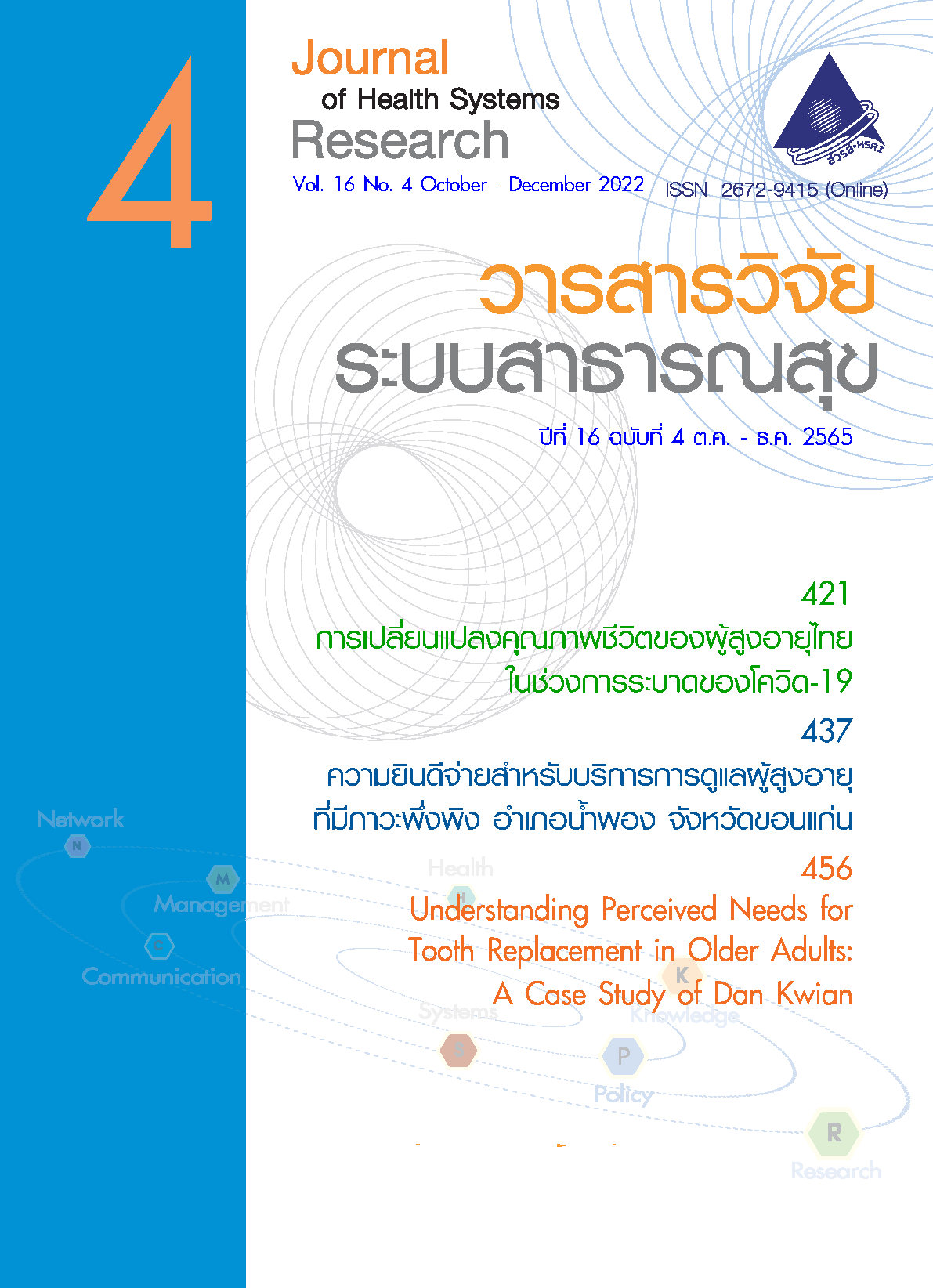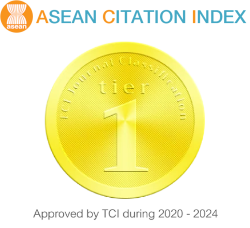Changes in Quality of Life among Thai Older Adults during Corona Virus-19 Pandemic
Keywords:
quality of life, older adults, COVID-19 pandemicAbstract
According to the situation of COVID-19 pandemic worldwide, policies and strategic measures managing the new normal restrictions may impact the quality of life, especially in the aging population. This study aimed to monitor and compare the quality of life across different periods of the COVID-19 pandemic in older adults stratified by regions in Thailand. Participants comprised 400 older adults living in provinces representing five regions in Thailand with a total number of 2,000 participants. The self-reporting questionnaires were applied for data collection, including personal and health information and the EQ-5D-5L quality of life Thai version (of high reliability 0.89). Descriptive statistics was utilized for overall personal and health information, and one-way analysis of variance was performed to examine the change of quality of life among different pandemic waves. Findings revealed that most of the provinces reported a higher quality of life and satisfaction of health at the first wave of the pandemic than others. The restriction policy decreased mobility in older people. Comparing each province, findings displayed that older people in Samut Prakarn had lower quality of life than others, such as Phrae province. It might be because Samut Prakarn province with high number of cases imposed a maximum infection control under a high restriction policy, while Phrae province with fewer cases enforced less restriction requirement. The findings on quality of life informed that the maximum infection control policy which decreased physical activity and lowered quality of life in older adults. Remarkably, the results of the present study showed that quality of life varied depending on pandemic waves and regions. These findings provided useful information to healthcare personnel and policymakers in Thailand to develop further plans and services for older people to cope with future pandemics properly.
References
World Health Organization. World Health Day 2012: ageing and health: toolkit for event organizers. Geneva: World Health Organization; 2012. [cited 2021 Nov 15]. Available from: https://apps.who.int/iris/handle/10665/70840.
Xavier FM, Ferraz M, Marc N, Escosteguy NU, Moriguchi EH. Elderly people’s definition of quality of life. Brazilian Journal of Psychiatry. 2003;25:31-9.
Chen Y, Klein SL, Garibaldi BT, Li H, Wu C, Osevala NM, et al. Aging in COVID-19: vulnerability, immunity and intervention. Ageing Res Rev. 2021 Jan;65:101205. doi: 10.1016/j.arr.2020.101205.
Martin PJ, Billet S, Landkocz Y, Fougère B. Inflammation at the crossroads: the combined effects of COVID-19, ageing, and air pollution. J Frailty Aging. 2021;10(3):281-5.
Meftahi GH, Jangravi Z, Sahraei H, Bahari Z. The possible pathophysiology mechanism of cytokine storm in elderly adults with COVID-19 infection: the contribution of “inflame-aging”. Inflamm Res. 2020;69(9):825-39.
WHO-China. Report of the joint mission on coronavirus disease 2019 (COVID-19) 16-24 February 2020. Coronavirus age, sex, demographics (COVID-19)— world meter [internet]. 2021 [cited 2021 Nov 15]. Available from: https://www.who.int/docs/default-source/coronaviruse/who-china-joint-mission-on-covid-19-final-report.pdf.
World Health Organization. WHO coronavirus (COVID-19) dashboard [internet]. 2021 [cited 2021 Nov 15]. Available from: https://COVID19.who.int/.
Wu B. Social isolation and loneliness among older adults in the context of COVID-19: a global challenge. Glob Health Res Policy. 2020;5:27. doi: 10.1186/s41256-020-00154-3.
Bornstein SR, Dalan R, Hopkins D, Mingrone G, Boehm BO. Endocrine and metabolic link to coronavirus infection. Nat Rev Endocrinol. 2020;16(6):297-8.
Bello B, Useh U. COVID-19: are non-communicable diseases risk factors for its severity? Am J Health Promot. 2021;35(5):720-9. doi: 10.1177/0890117121990518.
Roncon L, Zuin M, Rigatelli G, Zuliani G. Diabetic patients with COVID-19 infection are at higher risk of ICU admission and poor short-term outcome. J Clin Virol. 2020;127:104354. doi: 10.1016/j.jcv.2020.104354.
Zhou P, Yang XL, Wang XG, Hu B, Zhang L, Zhang W, et al. A pneumonia outbreak associated with a new coronavirus of probable bat origin. Nature. 2020;579(7798):270-3.
Zhang J, Wu J, Sun X, Xue H, Shao J, Cai W, et al. Association of hypertension with the severity and fatality of SARS-CoV-2 infection: a meta-analysis. Epidemiol Infect. 2020;148:e106. doi: 10.1017/S095026882000117X.
World Health Organization. COVID-19 and NCDs [internet]. 2021 [cited 2021 Nov 20]. Available from: https://cdn.who.int › docs › ncds › ncd https://cdn.who.int/media/docs/default-source/ncds/ncd-surveillance/ncd-rapid-as-sessment-covid-19-2021.pdf?sfvrsn=461793ac_1&down-load=true.
Wang B, Li R, Lu Z, Huang Y. Does comorbidity increase the risk of patients with COVID-19: evidence from meta-analysis. Aging. 2020;12(7):6049-57.
Greene MA, Loeser RF. Aging-related inflammation in osteoarthritis. Osteoarthritis Cartilage. 2015;23(11):1966-71. doi: 10.1016/j.joca.2015.01.008.
McGuigan FE, Bartosch P, Åkesson KE. Musculoskeletal health and frailty. Best Pract Res Clin Rheumatol. 2017;31(2):145-59.
Meessen JMTA, Leichtenberg CS, Tilbury C, Kaptein BL, Koster LA, Slagboom PE, et al. Frailty in end-stage hip or knee osteoarthritis: validation of the Groningen Frailty Indicator (GFI) questionnaire. Rheumatol Int. 2018;38(5):917-24.
O’Brien MS, McDougall JJ. Age and frailty as risk factors for the development of osteoarthritis. Mech Ageing Dev. 2019;180:21-8. doi: 10.1016/j.mad.2019.03.003.
Onder G, Rezza G, Brusaferro S. Case-fatality rate and characteristics of patients dying in relation to COVID-19 in Italy. JAMA. 2020;323(18):1775-6.
Docherty AB, Harrison EM, Green CA, Hardwick HE, Pius R, Norman L, et al. Features of 20133 UK patients in hospital with covid-19 using the ISARIC WHO Clinical Characterisation Protocol: prospective observational cohort study. BMJ. 2020;369: m1985. doi: 10.1136/bmj.m1985.
Chakrabarty B, Das D, Bulusu G, Roy A. Network-based analysis of fatal comorbidities of COVID-19 and potential therapeutics. IEEE/ACM Trans Comput Biol Bioinform. 2021;18(4):1271-80.
Department of Disease Control. Coronavirus disease 2019 situation report No. 710 [internet]. 2021 [cited 2021 Nov 20]. Available from: https://ddc.moph.go.th/viralpneumonia/file/situation/situation-no710-131264.pdf. (in Thai)
Brooks SK, Webster RK, Smith LE, Woodland L, Wessely S, Greenberg N, et al. The psychological impact of quarantine and how to reduce it: rapid review of the evidence. The Lancet. 2020;395(10227):912-20.
Mukhtar S. Psychosocial impact of COVID-19 on older adults: a cultural geriatric mental health-care perspectived. J Gerontol Soc Work. 2020;63(6-7):665-7. doi: 10.1080/01634372.2020.1779159.
Chen AT, Ge S, Cho S, Teng AK, Chu F, Demiris G, Zaslavsky O. Reactions to COVID-19, information and technology use, and social connectedness among older adults with pre-frailty and frailty. Geriatr Nurs. 2021;42(1):188-95.
Chu CH, Donato-Woodger S, Dainton CJ. Competing crises: COVID-19 countermeasures and social isolation among older adults in long-term care. J Adv Nurs. 2020;76(10):2456-9. doi: 10.1111/jan.14467.
Gorenko JA, Moran C, Flynn M, Dobson K, Konnert C. Social isolation and psychological distress among older adults related to COVID-19: a narrative review of remotely-delivered interventions and recommendations. J Appl Gerontol. 2021;40(1):3-13.
El Keshky MES, Basyouni SS, Al Sabban AM. Getting through COVID-19: the pandemic’s impact on the psychology of sustainability, quality of life, and the global economy - a systematic review. Front Psychol. 2020;11:585897. doi: 10.3389/fpsyg.2020.585897.
Siette J, Seaman K, Dodds L, Ludlow K, Johnco C, Wuthrich V, et al. A national survey on COVID-19 second-wave lockdowns on older adults’ mental wellbeing, health-seeking behaviours and social outcomes across Australia. BMC Geriatr. 2021;21(1):400. doi: 10.1186/s12877-021-02352-1.
Herrera MS, Elgueta R, Fernández MB, Giacoman C, Leal D, Marshall P, et al. A longitudinal study monitoring the quality of life in a national cohort of older adults in Chile before and during the COVID-19 outbreak. BMC Geriatr. 2021;21(1):143. doi: 10.1186/s12877-021-02110-3.
Rantanen T, Eronen J, Kauppinen M, Kokko K, Sanaslahti S, Kajan N, et al. Life-space mobility and active aging as factors underlying quality of life among older people before and during COVID-19 lockdown in Finland - a longitudinal study. J Gerontol A Biol Sci Med Sci. 2021;76(3): e60-e67.
Fried LP, Tangen CM, Walston J, Newman AB, Hirsch C, Gottdiener J, et al. Cardiovascular health study collaborative research group. Frailty in older adults: evidence for a phenotype. J Gerontol A Biol Sci Med Sci. 2001;56(3):M146-56. doi: 10.1093/gerona/56.3.m146.
Ministry of Social Developmentand Human Security (MSDHS). 2006 survey of vulnerability of Thai Elderly. 2006 [cited 2021 Nov 15]. Available from: http://www.m-society.go.th/main.php?filename=index. (in Thai)
Saraiva MD, Apolinario D, Avelino-Silva TJ, de Assis Moura Tavares C, Gattás-Vernaglia IF, Marques Fernandes C, et al. The impact of frailty on the relationship between life-space mobility and quality of life in older adults during the covid-19 pandemic. J Nutr Health Aging. 2021;25(4):440-7.
Brooke P, Bullock R. Validation of a 6 item cognitive impairment test with a view to primary care usage. Int J Geriatr Psychiatry. 1999;14(11):936-40.
Aree-Ue S, Youngcharoen P. A 6 item cognitive function test Thai version: psychometric property testing. RNJ 2020:26(2):188-202. (in Thai)
Pattanaphesaj J, Thavorncharoensap M. Measurement properties of the EQ-5D-5L compared to EQ-5D-3L in the Thai diabetes patients. Health Qual Life Outcomes. 2015;13:14. doi: 10.1186/s12955-014-0203-3.
Polit DF, Beck CT. Nursing research: principles and methods. Lippincott Williams & Wilkins; 2004.
Douglas M, Katikireddi SV, Taulbut M, McKee M, McCartney G. Mitigating the wider health effects of covid-19 pandemic response. BMJ. 2020;369:m1557. doi: 10.1136/bmj.m1557.
Downloads
Published
How to Cite
Issue
Section
License
Copyright (c) 2025 Journal of Health Systems Research

This work is licensed under a Creative Commons Attribution-NonCommercial-NoDerivatives 4.0 International License.
Journal of Health Systems Research is licensed under a Creative Commons Attribution-NonCommercial-NoDerivatives 4.0 International (CC BY-NC-ND 4.0) license, unless otherwise stated.




